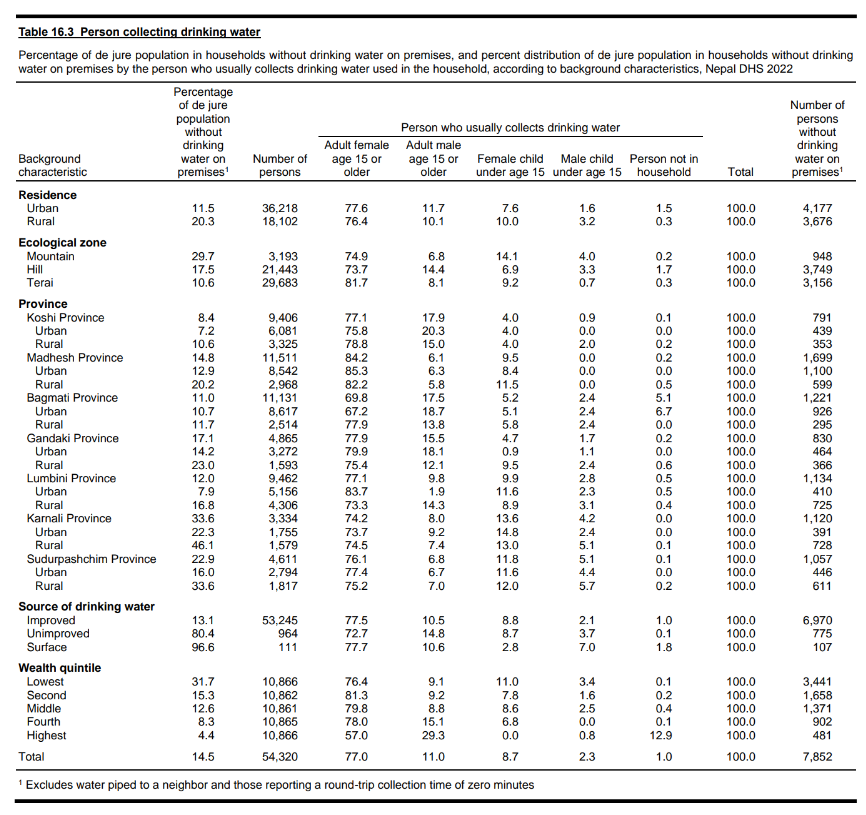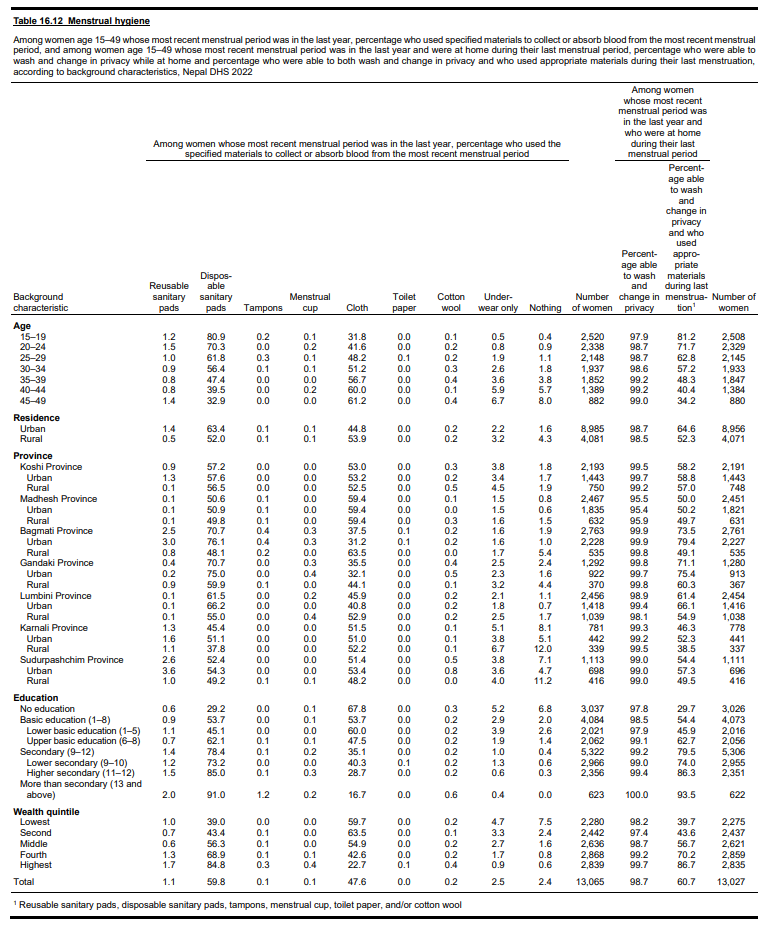New in DHS-8: Updates to WASH Indicators

In 2019, The DHS Program released updated questionnaires for the eighth phase of The DHS Program (DHS-8) to better meet existing and emerging data needs in global health. This “New in DHS-8” series draws attention to new indicators, changes made to existing indicators, and other things DHS Program data users should be aware of when accessing DHS-8 final reports and datasets.
Safe and sufficient quantities of drinking water, sanitation facilities, and hygiene (WASH) are vital for human health and well-being. WASH indicators have been included in demographic and health surveys since The DHS Program was launched in 1984. WASH indicators have been updated for DHS-8 surveys to align with WHO/UNICEF Joint Monitoring Programme for Water Supply, Sanitation and Hygiene (JMP) recommendations, and now include indicators on menstrual hygiene.
NEW: A dedicated WASH chapter
For the first time, WASH data are compiled into their own chapter. Historically, WASH indicators in DHS surveys have been provided for both households and the de jure population. In DHS-8, data users will see a greater emphasis on population-based indicators to align with Sustainable Development Goal 6: clean water and sanitation for all.
UPDATED: Drinking water service ladder
The JMP has introduced a 5-rung drinking water service ladder to track progress towards achieving SDG indicator 6.1.1: proportion of population using safely managed drinking water services. The ladder expands upon the improved/unimproved source classification system collected in past phases of DHS surveys. DHS-8 surveys capture information on 4 of the 5 rungs; the highest rung – the population using a safely managed service – requires testing drinking water for fecal or chemical contamination. Because such testing is not standardly conducted in DHS surveys, safely managed and basic are grouped together and reported as “at least basic” drinking water service in DHS final reports.
UPDATED: Availability of sufficient quantities of drinking water
Sufficient quantities of water are vital to health and wellbeing. DHS-7 surveys collected information on water availability in the past 2 weeks for households using piped water or water from a tube well or borehole. DHS-8 surveys now collect information on water availability in the past month, regardless of household water source.
NEW: Person collecting drinking water
In DHS-8 surveys, households that do not have drinking water on their premises are asked who usually fetches the water; the person’s name and line number from the Household Questionnaire are recorded. This enables final reports to include a tabulation of the percent distribution of the household population without drinking water on the premises by the sex and age of the person who usually collects the drinking water (Table 16.3 in the 2022 Nepal DHS final report). Because these individuals’ basic demographic information are also collected in the Household Questionnaire, interested researchers may further analyze the characteristics of the household members usually responsible for collecting water. DHS Program data users may be aware that a similar indicator was tabulated in DHS-5, but it was not linked to a specific individual and thus the analysis possibilities were much more limited.

UPDATED: Sanitation service ladder
The JMP has also introduced a 5-rung sanitation service ladder to track progress towards SDG indicator 6.2.1: proportion of population using (a) safely managed sanitation services and (b) hand-washing facility with soap and water. Like the drinking water ladder, the sanitation ladder expands upon the established improved/unimproved facility type classification system used in past phases of DHS surveys. Data users will now find information on the household population with “at least basic” sanitation service.
UPDATED: Disposal of children’s stools
Disposal of children’s stools, an indicator previously reported in the child health chapter, has been moved to the WASH chapter and updated. Stools are considered disposed of appropriately if the child used a toilet or latrine or if the fecal matter was put or rinsed into a toilet or latrine. Stools that are buried are no longer considered “appropriately disposed of”.
NEW: Management of household excreta
For those households with an improved onsite sanitation facility (defined as an improved facility where the excreta are stored in a septic tank, pit latrine, or composting toilet), DHS-8 surveys now ask about the emptying and disposal of household excreta. This information is needed to report on the percent of the household population that appropriately manages their household excreta: that is, the population living in households connected to a sewer, in households where excreta is safely disposed of on-site (septic tanks and pit latrines that are never emptied or in which waste is buried in a covered pit), and in households that have excreta removed for treatment off-site. The household population relying on unimproved sanitation facilities and open defecation as well as those using improved on-site facilities where the excreta are emptied into uncovered pits, open ground, water bodies, or other locations do not have safely managed waste disposal.
NEW: Safe management of menstrual hygiene
Women are asked about the materials used to collect or absorb blood from their most recent menstrual period, and whether they were able to wash and change in privacy. This information is combined to tabulate a new indicator: the percentage of women who were able to wash and change in privacy and women were able to wash and change in privacy and who used appropriate materials during their last menstruation. Data users should note that what qualifies as “appropriate materials” may vary depending on the country. In Nepal for instance, appropriate materials include reusable sanitary pads, disposable sanitary pads, tampons, menstrual cup, toilet paper, and/or cotton wool.

Feature image: © matiplanas / Adobe Stock




